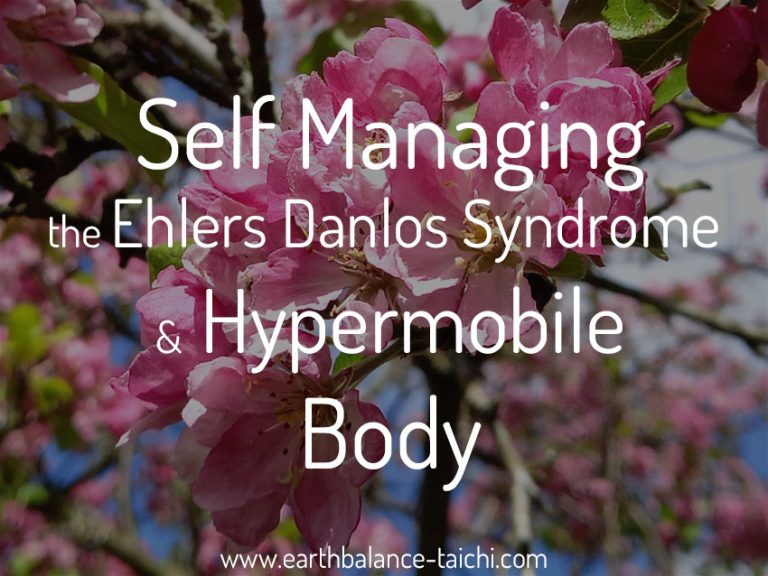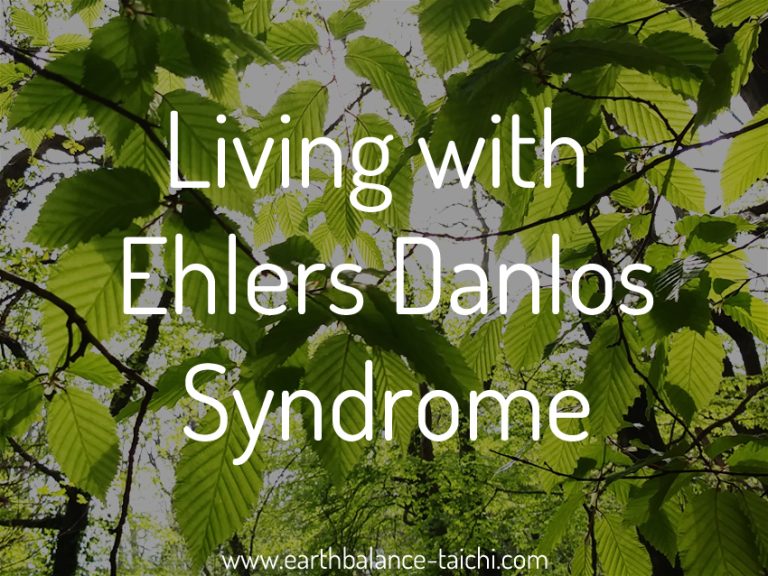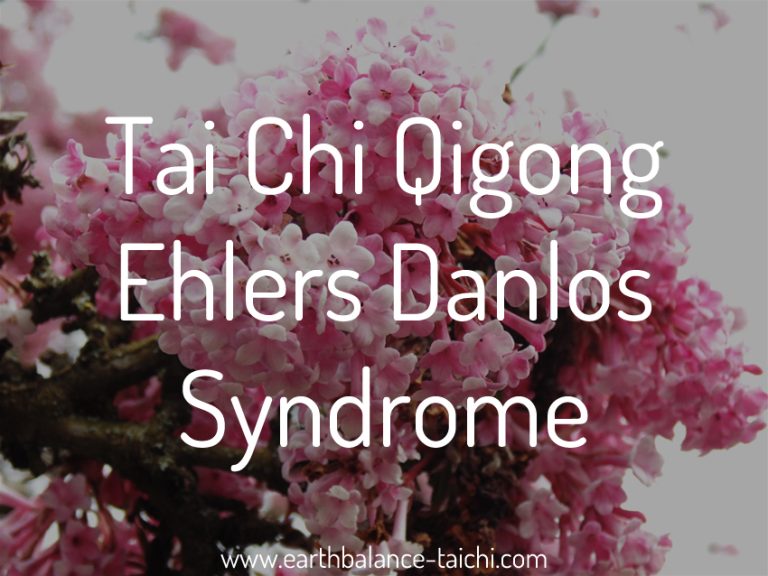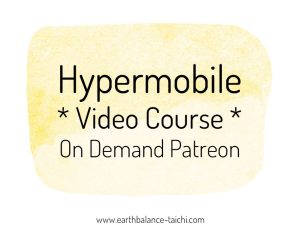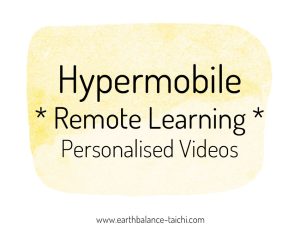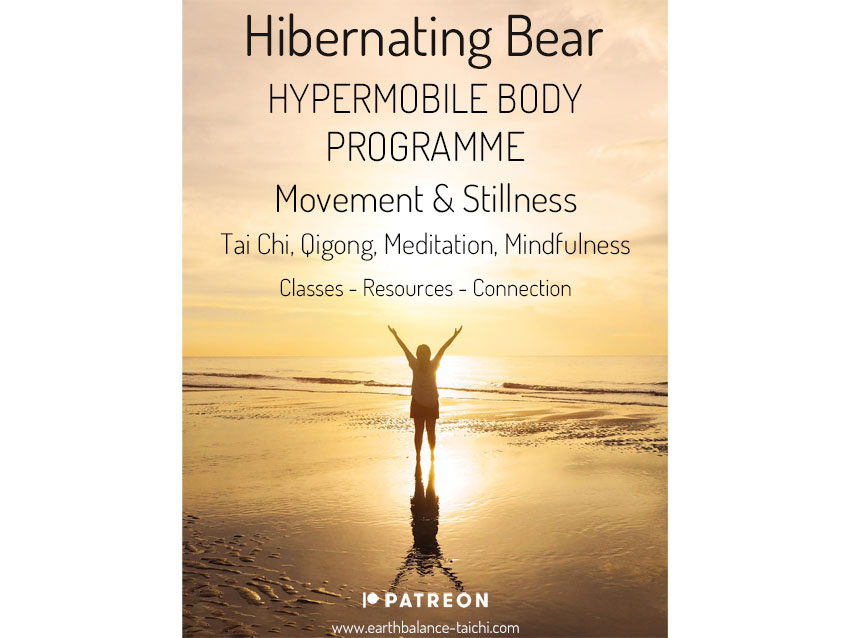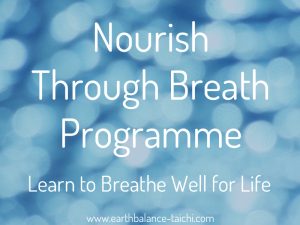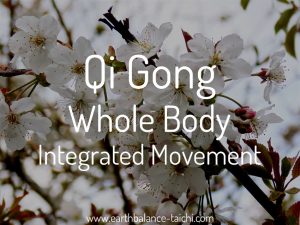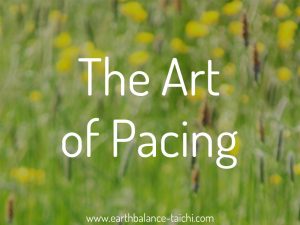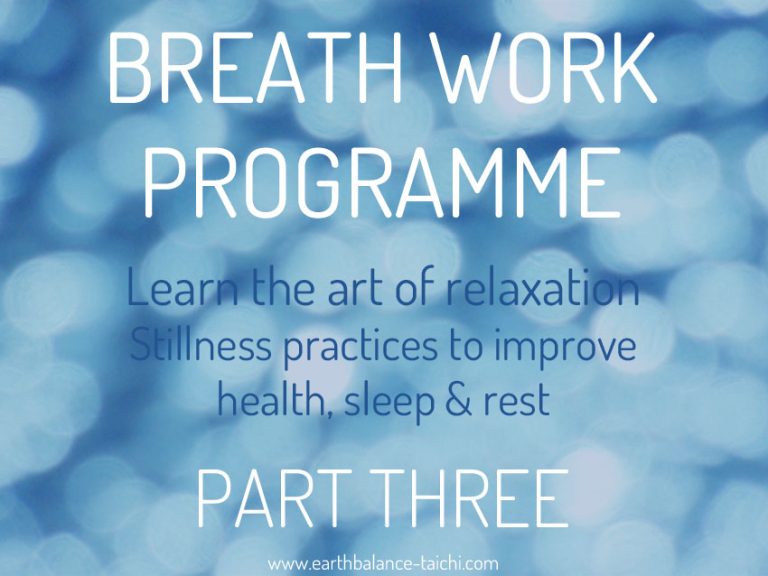Tai Chi and Hypermobility Joint Syndrome
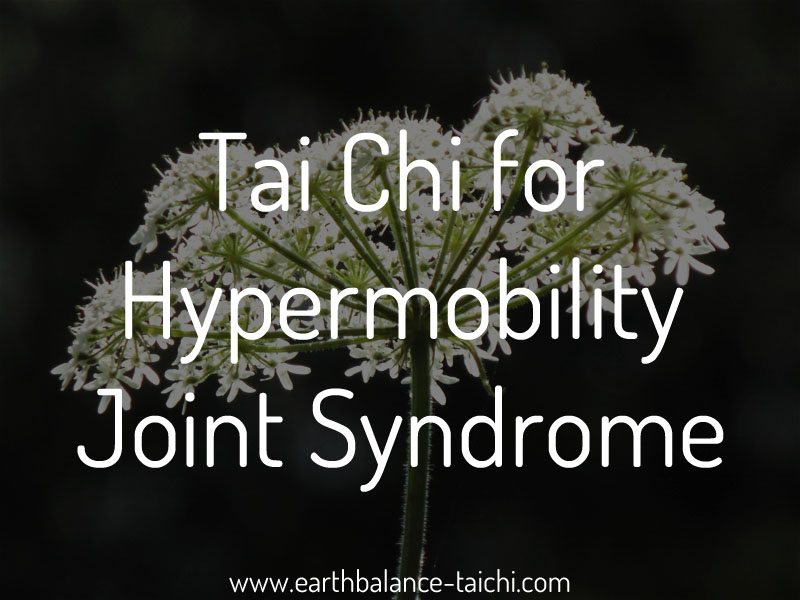
Tai Chi and Hypermobility Joint Syndrome
As a Tai Chi Instructor I live with hypermobility. The good news is that Tai Chi, Qi Gong and Meditation are all recommended ways to help manage the symptoms of this connective tissue disorder. This article explores Tai Chi and hypermobility joint syndrome and the health benefits of using this ancient practice to support the symptoms of pain and fatigue.
I changed career in 2010 to become a Tai Chi and Qigong instructor when my physical health went through many changes. I chose to adapt my life to try to be gracefully productive. I can no longer stay seated, walk, lie down or do any activity for long periods, as these all lead to chronic/acute pain, reduced mobility, excessive muscular contraction and fatigue. You can read more about my personal journey here. Over these years, the gentle and powerful movements helped me to maintain my mobility, manage chronic pain and chronic fatigue. Over the years there has been much ebb and flow as I try to manage the symptoms and find a work life balance. It's been trial and error and I haven't always got it right. Living with hypermobility is about adaptation, compassion and grit. It's a very difficult journey to be on and my heart goes out to you all.
Hypermobility Joint Syndrome can be a symptom of other conditions, e.g. Ehlers Danlos Syndrome is a systemic connective tissue disorder, where the lack of collagen affects all connective tissue in the body.
What causes hypermobility? Read this article by Dr. Bruno, a licensed acupuncturist and herbalist in the state of Texas, who I highly recommend as a hypermobility professional.
Tai Chi and Hypermobility Syndrome
Hypermobility is an invisible condition, no one knows what it means for an individual. I certainly don't act like I am 'sick' and I don't move like a typical 'ill person'. No one can see what goes on in my body, the effect on the bones, veins, muscles, organs and connective tissue, the lack of healing and ease of injury, nor the mark it leaves trying to live a normal life. This video discusses HJS and 'new and emerging manual therapies'. It mentions the benefit of qigong and tai chi, along with breathing exercises.
Condition
- Hypermobility joint syndrome is a genetic connective tissue disorder caused by a collagen defect
- Connective and soft tissues are more elastic
- Joints move beyond their normal range of motion (double jointed)
- Causes joint instability
- Hyperextension of joints
Primary Symptoms
- Connective tissue, soft tissue, vascular and dermal weakness due to lack of collagen
- Vascular, digestive, urinary dysfunction
- Varying degrees of acute and chronic pain
- Unpredictable and ease of injury; sprain, dislocation, partial dislocation, torn muscles, torn skin, bruises
- Inflammation
- Chronic muscular contraction
- Posture/joints cannot support the body, the body 'collapses' on itself
- Joint pain when weight/pressure applied for too long a time period in one position e.g. sleeping / sitting
- Leads to chronic fatigue from muscular exhaustion, constant pain and the constant need to move/adjust the posture.
- Early onset of arthritis
- Low level of proprioception (knowing where you body is in space or knowing how your limbs are oriented to your body)
- Secondary symptoms are noted in detail in this Hypermobility Syndrome Blog
Supporting the Hypermobile Body
First let's take a look at the common symptoms and reasons to avoid exercise with a hypermobile body.
Loose Painful Joints
- Joints can subluxate or dislocate, or hyper extend or hyper compress.
- Ever collapsing posture that is exhausting to hold up appropriately.
- Neck instability, feeling like the head is too heavy to hold up.
- Joint instability, fear of movement and fear of stillness.
- Do not know what to do to stabilise the joints safely.
Tightly Contracted Muscles
- Hyper contraction through trying to stabilise the joints.
- Unpredictable injuries, inability to grow muscle mass, muscles tear easily.
- Do not know what to do to release physical tension.
Un-Elastic Connective Tissue
- The ligaments, tendons, sinews and fascia systems do not have the same flexibility and pliability as a healthy body.
- Leading to pain, tightening sensations, like the body is being pulled into the foetal position.
- Unpredictable injuries and easy to tear the connective tissue.
- Do not know what to do to release physical tension.
Chronic and Acute Pain
- Always in varying degrees of pain.
- Living with several types or categories of pain.
- Exercise seems to worsen pain, as much as being still seems to worsen pain, feels like a no win situation.
- Do not know how to help lessen pain.
- Feel like you are living your pain viscerally, that it is in control of you.
- Feels like you are fighting the pain daily.
Chronic Fatigue
- Always tired and exhausted, without an off switch.
- Feel like everything is forced, to be able to live your life.
- Always seem to fall into the boom and bust cycle of pushing too much and living with the consequences for a few days to a few weeks.
- Cannot seem to understand your changing baseline.
- If you push yourself to exercise, it's just too much.
- Do not know how to help fatigue.
- Feels like you are fighting yourself over being exhausted.
Fear of Movement
- Developing a fear of exercise as do not feel safe exercising due to impact on pain, joints, connective tissue and fatigue when going outside of a safe range of motion.
- Exercise in the past has meant an increase in fatigue and pain levels.
- Do not know what to do to move or exercise safely.
- Do not understand the benefits on the hypermobile body when exercising daily / frequently.
Fear of Stillness
- Developing a fear of being still as gravity is ever pulling the joints down into a compression which over compresses or hyper extends the joints depending on what position you are being still in.
- Stillness can increase fatigue and pain levels.
- Feels like you must keep moving to keep redistributing the weight around the joints.
- Do not know what to do to help in the times you need to be still e.g. work, sleep, rest, cinema, driving etc.
Poor Proprioception
- It is well documented by medical professionals that people with a hypermobile syndrome have a reduced capability of proprioception, which is body awareness, knowing where you body is located in space without using your eyes.
- This can increase the chances of injury in the hypermobile joints due to low body awareness, which makes exercise much more difficult, as you likely will go too far without even knowing.
- This can decrease confidence in exercise and cause someone to stop exercising.
Memory & Processing
- Living with chronic pain and chronic fatigue has an impact on brain functioning.
- It is typical to live with brain fog, memory and recall problems and difficulty processing.
- Whether this be mixed up speech when talking, or not being able to find the right words, to not being able to function cognitively as you used to.
- Sustained pain and fatigue is brutal on the brain. It is not that your brain is any less, you are just dealing with too much and this is taking precious resources away from your brain.
Low Mental Health
- People living with chronic illness, chronic pain, chronic fatigue, and physical restrictions are more likely to experience low mental health, with symptoms of anxiety and depression being common.
- From frustration at not being able to do the things you used to do.
- To anger at being in pain constantly.
- To feeling numb from fatigue.
- To feeling like a burden on other people.
- To feeling misunderstood by everyone.
- To feeling lethargic and run down.
- To isolation and loneliness as your world has gotten smaller.
- These are a mere few, there are many many more knocks on effects to our emotional wellbeing when living with hypermobility. All invisible.
It Doesn't End There
- This list is not meant to be exhaustive or finite as everyone is different. Our hypermobile bodies are all individual and we sometimes experience the same symptoms and sometimes have many differences. Leave a comment below with more suggestions from your own personal experience.
Read More
- My webpage dedicated to self management strategies for the hypermobile body - looking at each part step by step.
- A holistic view of chronic illness and how the whole of life is effected.
Tai Chi and Hypermobility Joint Syndrome - Video Class Snippet
Benefits of Tai Chi and Hypermobility Joint Syndrome
Tai Chi and Qigong
The Hypermobility Blogspot passes on that Tai Chi (and in turn Qi Gong) are recommended exercises for hypermobile syndromes as these practices fall into the category of "joint-healthy physical activities". Tai Chi and Qi Gong are low impact, gentle yet powerful movements that aid all body systems including joint health. The slow meditative practice also helps to improve proprioception by building up a heightened sense of body awareness. You can learn to align your posture correctly without exaggerating the over extension of the joints, whilst releasing physical tension.
Importantly the movements are accessible to all abilities, even when lying down some gentle movements can be performed, or when sitting in a chair or when standing and able to move around. The intensity is up to you. Having an off day, sit down and focus on arms movements and breath work. Having a good day, do the Tai Chi form with flowing, stepping and one legged postures. That is the beauty of the practices, you choose. There is no gym mentality of 110% of let's go. It is working within a safe range of around 70% of your ability, no extremes in either direction. Giving you longevity in the practices, not crashing and burning.
Tai Chi is also recommended by Dr. Alan G. Pocinki who wrote a medical paper titled "Joint Hypermobility and Joint Hypermobility Syndrome". He stated "AVOID high-impact exercises, such as sports that involve running, jumping, or physical contact. Swimming or water exercises, walking, Pilates, and Tai Chi are good choices. Some forms of yoga are OK, but others are not." These ideas are echoed in the article "Pain in the Joint Hypermobility Syndrome (JHS)" by Dr. Jaime F. Bravo, Rheumatology-Osteoporosis.
By learning Tai Chi and Qigong movements, you can help rebuild and stabilise your hypermobile body. It is an ongoing daily effort that takes time, patience and perseverance. It is worth every ounce of regular effort you can make;
- Stabilise the joints and learn a safe range of motion
- Release inappropriate muscle contraction
- Elasticise the connective tissue
- Learn to manage chronic and acute pain
- Learn to reframe the pain experience
- Learn how exercise with breath work can reduce pain levels
- Become an expert in your own experience of chronic fatigue
- Learn to work with the ebb and flow of your health baseline with grace and kindness
- Learn to pace appropriately
- Develop confidence to exercise on your own
- Develop confidence and strategies to help when being still
- Improve your level of proprioception and body awareness
- Gain clarity, improve memory and processing
- Learn how your posture can be held more efficiently to use less of your resources
- Improve your mental health through mindful movements, healthy distractions and by tapping into the mind and body connection
- Learn about the absence of resistance in mind and body
- Release inner conflict
- Foster self compassion
- Find peace, softening and release within adversity
- Exercise to detox the lymph system
- Exercise to boost happy brain hormones
- Exercise to release pain relieving hormones
- Breath work to activate the vagus nerve to regulate the stress response
- Exercise to improve the functioning of all body systems
Breath Work
At the core is break work which when in a bad flare may be the only practice you can do. It can be done anywhere and anytime, and the techniques for breath work are easy and simple. It is often overlook as a practice and yet has such a deep and transformational quality on the mind and body, it needs more good press! Developing a breath work practice is one of the easiest strategies to make. It brings you into a mindfulness state of that single point of focus. Slowing the breath down, slowing the mind down, and starting to slow the body down. All leading to entering into the relaxation response, the rest and digest state, where your mind and body are at peace. Read more about the benefits of breath work here.
Meditation & Mindfulness
Meditation is also recommended to calm the mind, clear away the cobwebs of the mind, reduce the symptoms of anxiety and depression, bring you into the present moment with fear of the past or worry about the future, all whilst helping to release and reduce the amount of physical tension you are carrying. From simple techniques to the more complex, it really does not matter what type of meditation practice you do. 5 minutes per day is consistently achievable for anyone. And if you fall asleep, does it matter? No.
Tai Chi and Hypermobility Joint Syndrome
Online Classes
I created the Hibernating Bear programme as a way to help others self manage the symptoms of hypermobility syndromes through safe exercise and nourishing stillness practices. Using Tai Chi, Qigong, meditation, mindfulness and relaxation techniques to soften, strengthen and release. As someone who has to work hard every day to manage my own symptoms within the hypermobile body, I have first hand knowledge matched with professional study and experience to help guide you towards building resilience in mind, body and spirit. It is possible to start from scratch with exercise, to slowly and gently work with the body over time to rebuild and strengthen. It is also possible to lessen the pain experience through movement and stillness, to help you cope better with the routines of daily life. I am here to support and guide you on that journey. Whether through our group online classes within Patreon or working with your privately online via Zoom. Every step you can take towards improving self care is worth the effort!
* Tai Chi and Hypermobility Joint Syndrome - Please note that the Taoist practices are not a replacement for conventional medical treatment. Please speak with your doctor prior to starting a new exercise programme. This article is for information purposes only and must not be taken as medical advice. *
